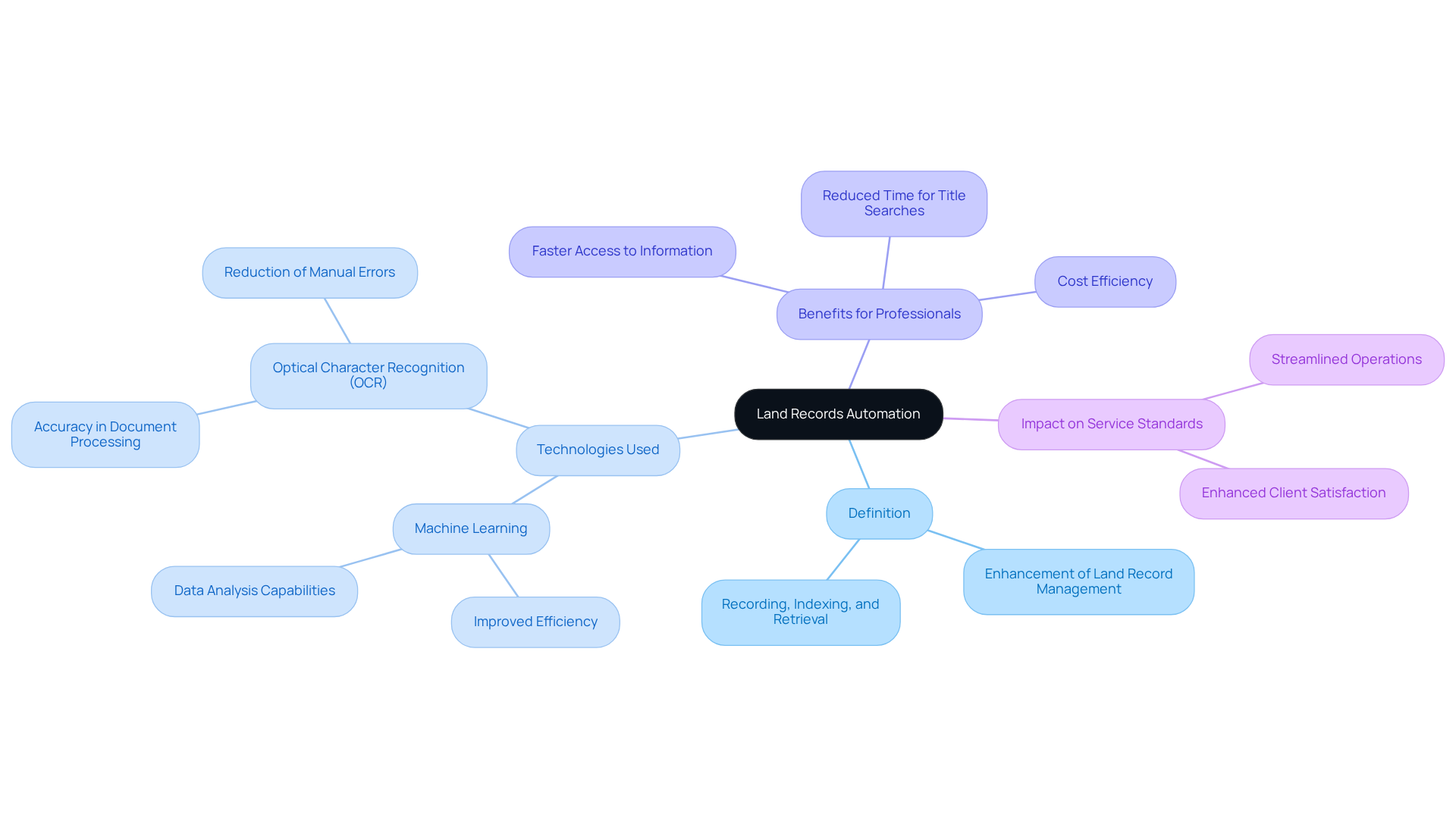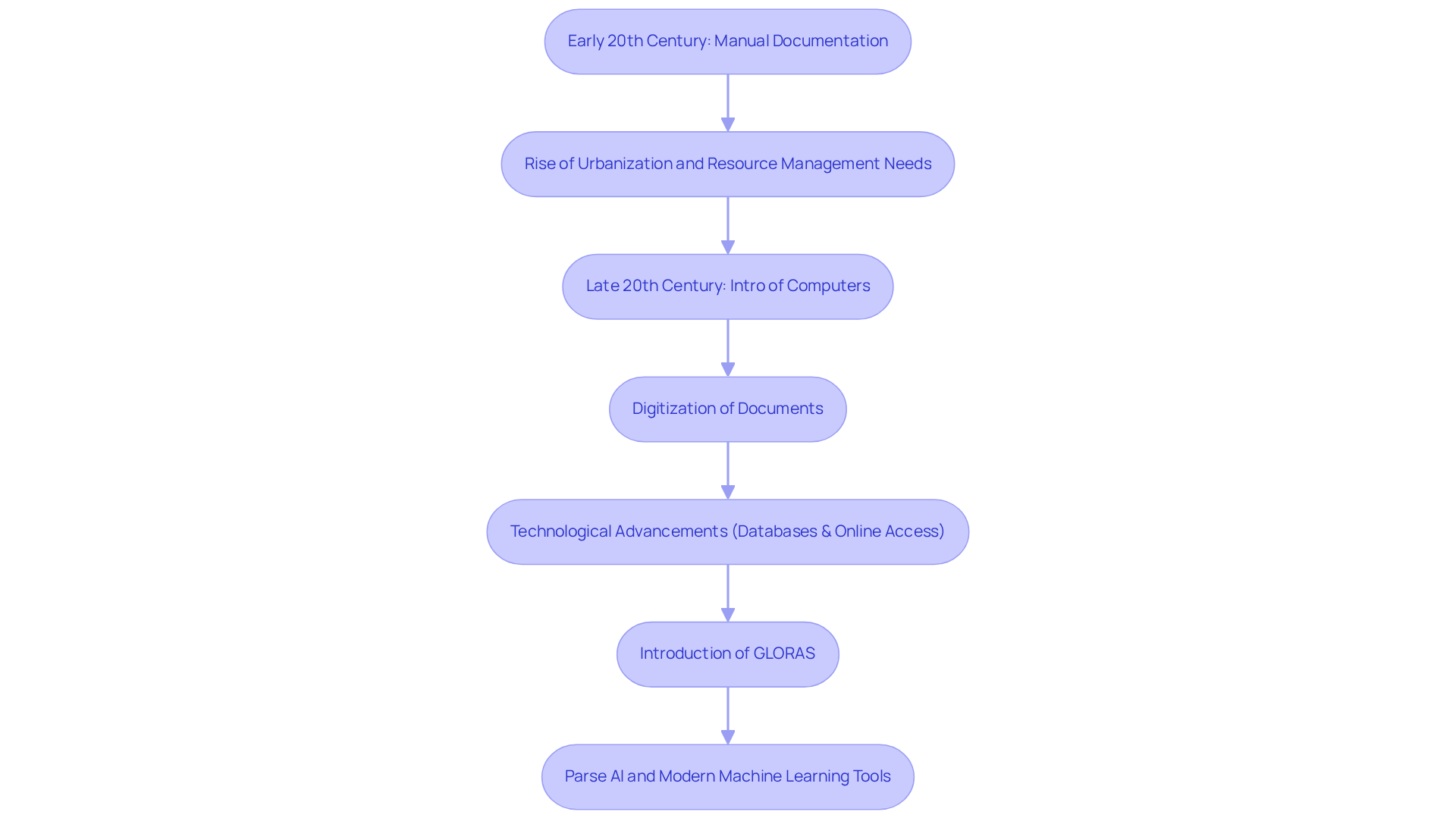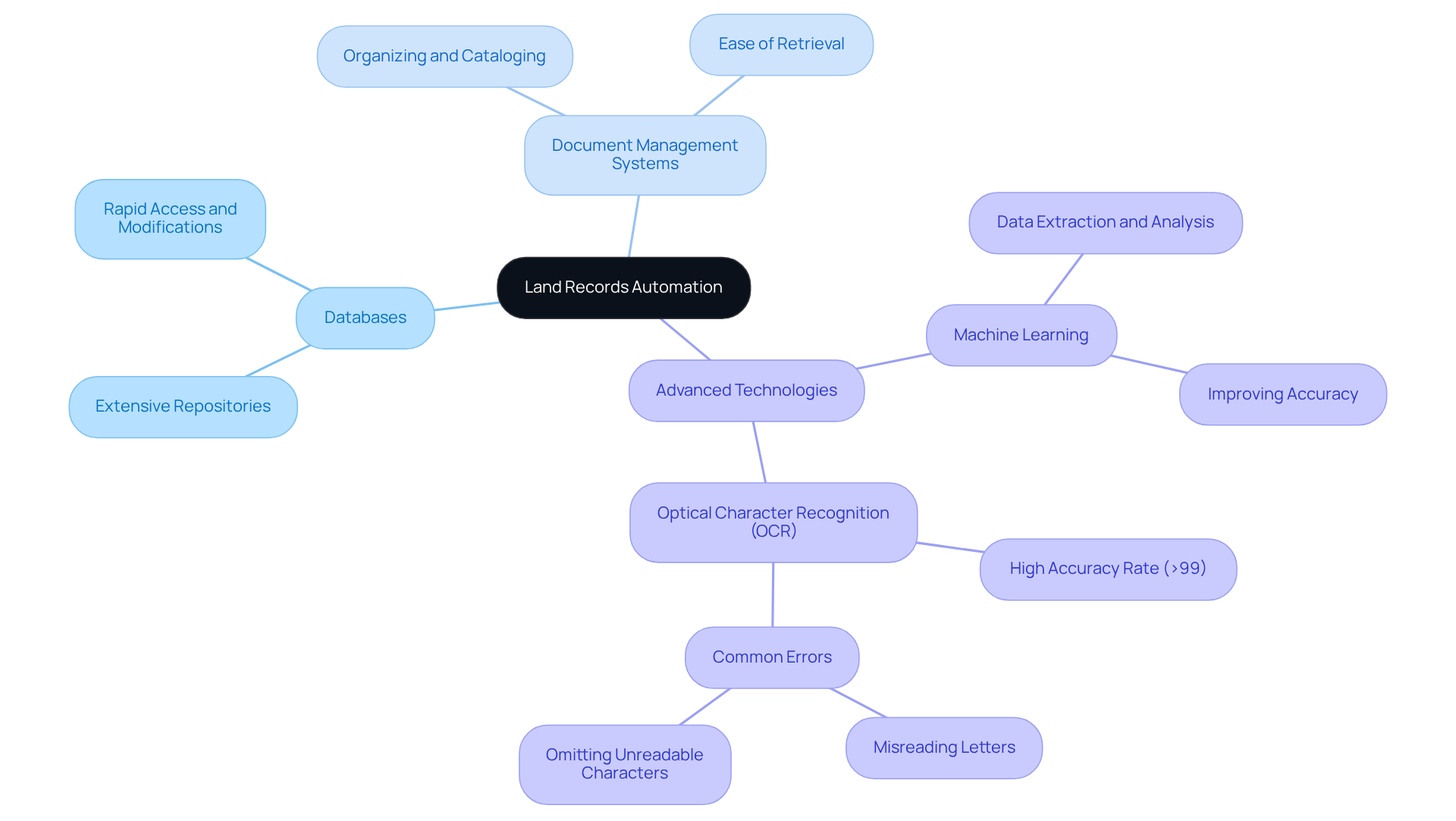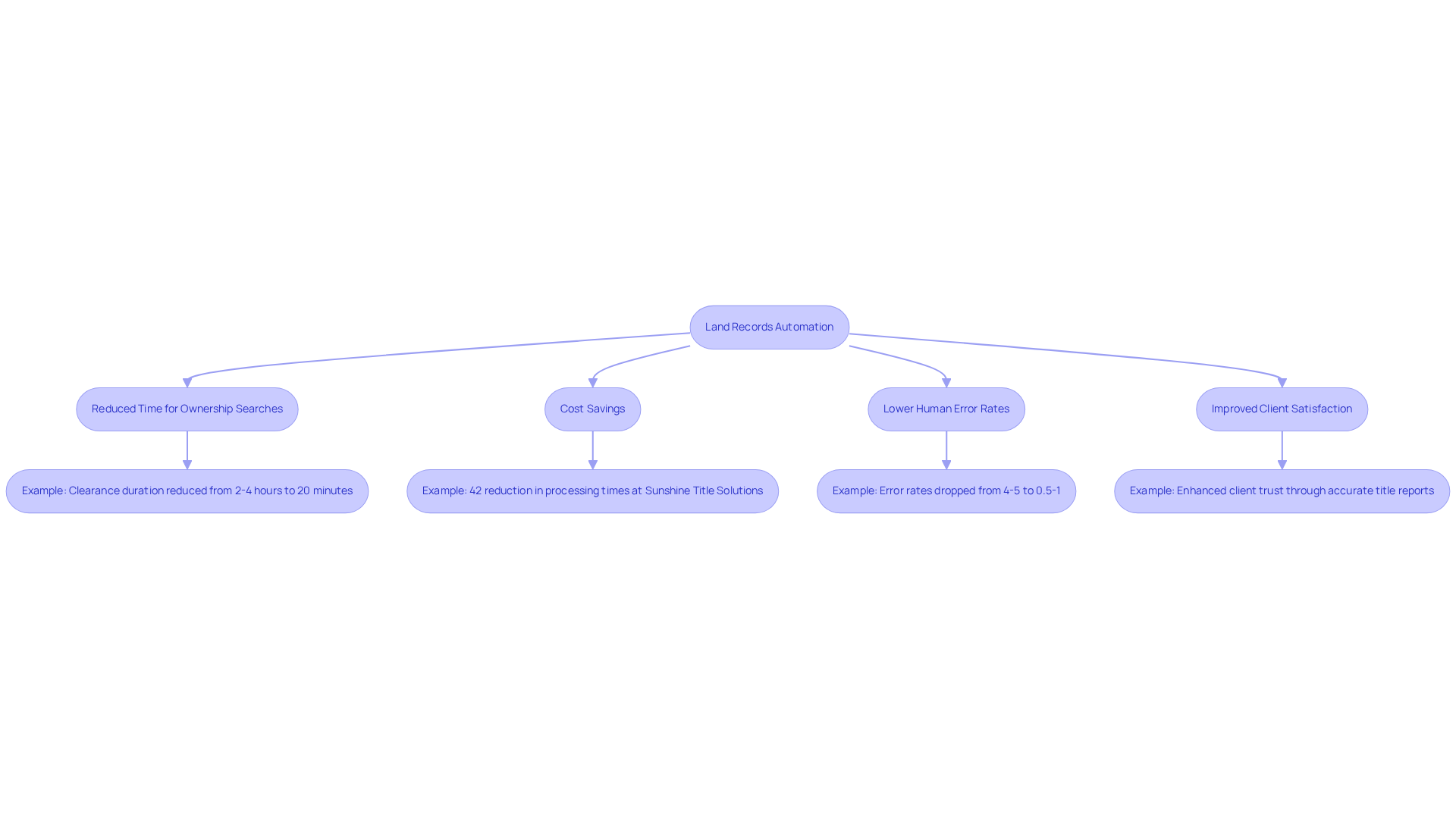Overview
Land records automation represents a significant technological advancement that enhances the management of property ownership documents. This innovation markedly improves the efficiency and accuracy of title research. The article underscores this importance by detailing how automation effectively reduces the time and costs associated with ownership searches.
Furthermore, it minimizes human error, ultimately elevating client satisfaction through more reliable and timely service delivery.
Introduction
The management of land records has experienced a revolutionary transformation, propelled by the integration of advanced technologies that enhance both efficiency and accuracy. Land records automation streamlines the processes of recording and retrieving property ownership documents, significantly reducing the time and resources traditionally required for title research.
However, as this innovative approach reshapes the real estate landscape, questions arise:
- How can industry professionals fully leverage these technologies to improve their operations?
- What challenges remain in this digital evolution?
Addressing these questions is crucial for maximizing the benefits of this transformation.
Defining Land Records Automation
Understanding what is land records automation is crucial as it represents a pivotal advancement that employs technology to enhance the management of land records, specifically the recording, indexing, and retrieval of property ownership documents. This innovative system leverages cutting-edge technologies such as machine learning and optical character recognition (OCR), significantly improving the efficiency and accuracy of research processes. Consequently, real estate professionals can access essential information more swiftly, thereby reducing the time and resources traditionally required for title searches and property transactions. By embracing digitization, the industry not only streamlines operations but also elevates the standards of service provided to clients.

Historical Context and Evolution of Land Records Automation
The development of property documentation automation began in the early 20th century, a time marked by manual documentation methods. With urbanization on the rise and populations expanding, the need for more effective resource management systems became increasingly evident. The late 20th century heralded a pivotal transformation with the advent of computers, which enabled the digitization of documents and streamlined processes. Over the years, technological advancements, including sophisticated databases and online access systems, have revolutionized property management.
Notably, the General Land Office Records Automation System (GLORAS) exemplifies what is land records automation by showcasing how modern technology enhances accessibility and efficiency in managing land documents. Today, Parse AI spearheads this evolution, offering advanced machine learning tools that expedite document processing and streamline research. By leveraging cutting-edge technologies, Parse AI significantly enhances courthouse document processing through features such as full-text search and machine learning extraction, fundamentally altering what is land records automation for landmen in generating runsheets and managing title information.
This commitment to improving real estate solutions through collaboration with industry experts positions Parse AI as a leader in the ongoing evolution of property documentation.

Key Components and Technologies in Land Records Automation
The essential elements of property documentation automation include:
- Databases
- Document management systems
- Advanced technologies such as machine learning and optical character recognition (OCR)
Databases serve as extensive repositories for property documents, facilitating rapid access and modifications. Document management systems play a critical role in organizing and cataloging these files, ensuring users can readily retrieve the information they need. Furthermore, machine learning algorithms significantly enhance the accuracy of data extraction and analysis, while OCR technology boasts an impressive accuracy rate of over 99% in converting scanned documents into editable and searchable formats. However, OCR technology is not without its challenges; it often encounters common errors, such as misreading letters and omitting unreadable characters.
Collectively, these elements create a robust framework for effective property management, which helps illustrate what is land records automation. As Mark Cuban emphasizes, understanding AI and machine learning is crucial to avoid obsolescence, highlighting the importance of these technologies in property documentation. Moreover, the Database Automation Market is projected to reach USD 2.92 billion by 2025, which highlights what is land records automation and the increasing demand for automated solutions in land management.

Practical Applications and Benefits in Title Research
What is land records automation? It represents a transformative approach to ownership research, delivering substantial advantages that enhance operational efficiency. Automated systems can significantly reduce the time needed for ownership searches, enabling researchers to complete their tasks in mere hours rather than the weeks or months typically required by conventional methods. This remarkable efficiency not only streamlines processes but also results in considerable cost savings, as labor and resource expenditures are minimized. For instance, a national firm recently reduced clearance duration from 2-4 hours to just 20 minutes, achieving a tenfold decrease in manual data entries.
Furthermore, mechanization dramatically lowers the incidence of human error, with the manual data entry error rate plummeting from 4-5% to a mere 0.5% to 1% through the application of Optical Character Recognition (OCR) technology. This advancement leads to more accurate title reports and abstracts, fostering enhanced client satisfaction and trust. Sunshine Title Solutions, for example, reported a 42% reduction in processing times and a 33% decrease in error rates after implementing an AI-driven document analysis system, illustrating the tangible benefits of automation.
By embracing these technological advancements, real estate professionals can effectively streamline their workflows, improve service delivery, and ultimately achieve superior business outcomes.

Conclusion
Land records automation represents a transformative shift in the management of property documentation, leveraging advanced technologies to enhance the efficiency and accuracy of title research. By integrating innovative solutions such as machine learning and optical character recognition (OCR), this approach streamlines the retrieval and processing of land records, significantly improving the service delivered to clients within the real estate sector.
Key insights throughout the article reveal the historical evolution of land records automation, illustrating its journey from manual documentation to sophisticated automated systems. The discussion emphasizes critical components, including:
- Databases
- Document management systems
alongside substantial benefits realized through automation:
- Reduced processing times
- Lower error rates
- Considerable cost savings
Real-world examples showcase how firms have successfully harnessed these technologies to transform their operations and elevate client satisfaction.
The implications of land records automation extend beyond mere efficiency; they underscore the necessity for real estate professionals to adapt to technological advancements to remain competitive. Embracing automation fosters improved accuracy and speed in title research, positioning the industry for future growth. As demand for automated solutions continues to rise, the call to action is clear: stakeholders must invest in these transformative technologies to secure their place in an evolving landscape and deliver exceptional value to their clients.
Frequently Asked Questions
What is land records automation?
Land records automation refers to the use of technology to improve the management of land records, including the recording, indexing, and retrieval of property ownership documents.
What technologies are utilized in land records automation?
Technologies such as machine learning and optical character recognition (OCR) are employed in land records automation to enhance efficiency and accuracy.
How does land records automation benefit real estate professionals?
It allows real estate professionals to access essential information more quickly, reducing the time and resources needed for title searches and property transactions.
What impact does digitization have on the land records management process?
Digitization streamlines operations and elevates the standards of service provided to clients in the real estate industry.




